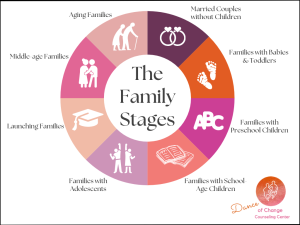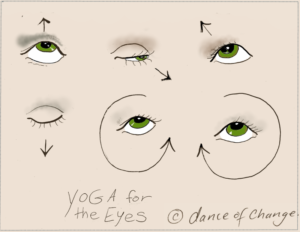The Wide View: What To Know About You and Your Child’s Development
Children grow and change at different rates due to a combination of factors. Some of those have to do with your child’s unique traits, their personality, temperament, and genetic inheritance. Others are external influenced by your unique family culture, parenting style, and broader environmental factors. When challenges arise, family therapy can provide valuable support, helping parents and children navigate these changes with greater understanding and ease.
Because development is complex, it’s important to take a big-picture view rather than focusing on just one aspect. A child therapist or family therapist will assess all these factors together, and we encourage you to do the same. By keeping a wide perspective, you’ll navigate each stage with greater clarity and less frustration.
A Note about Family Stages And Family Therapy
Change is not linear, and neither is child development. The stages outlined here are not rigid guidelines, but flexible roadmaps. Each family’s journey will be unique. Unexpected growth spurts, personal wins, or strong support systems can propel a child forward. Conversely, challenges like divorce, trauma, setbacks, or major life changes may slow progress.
Every family has its own strengths and struggles. What matters most is recognizing when extra support is needed and knowing help is available.
When Family Therapy is Needed
Family therapy, child therapy, or teen therapy may be helpful when:
- You, your child, or both are struggling to navigate a particular stage.
- You’re experiencing communication difficulties, ongoing tantrums, behavioral issues, or persistent anxiety/depression.
- Situations out of your control (or even personal choices) are making family life stressful.
- Emotional or behavioral issues seem like just the tip of the iceberg, indicating deeper challenges that need to be addressed together.
A Note for Parents with Multiple Children
If you are a parent of two or more kids, you will likely be navigating multiple stages at the same time. You may also find that even if you’ve been through a developmental stage before, it feels entirely different with each child. As you grow as a parent, your approach will evolve. What worked for your first child at age 5 may not work for your second. And that’s okay. Parenting is a dynamic process, not a fixed formula.
The Family Stages
Pregnancy: Preparing for Your Baby’s Arrival
Your Family Stage: Preparing for the new family member.
Your Baby’s Stage: Rapid physical and neurological development.
Your Task:
- Prepare a safe and nursing space for your baby by gathering support and resources
- Research parenting philosophies to align with your personal values
- If you are part of a couple, now is the time to get on the same page as your partner about parenting roles, expectations, and support
- Recognize that bonding begins to happen even in utero
Your Experience as a Parent: You may feel a combination of excitement, anxiety, or both at this time. If you are part of a couple, you will also be experiencing changes in your relationship or marriage as you prepare for parenthood.
When to Seek Therapy:
- Extreme anxiety or overwhelm about the transition to parenthood
- Lack of support at this important life stage from family, friends, or your partner
- Unresolved relationship stress that can impact co-parenting
Related Article: The Couple Bubble: Your Complete Guide to Protecting Your Marriage
Postpartum & Your Baby’s First Year
Your Family Stage: Adjusting the family system to accommodate children and defining roles within your family.
Your Baby’s Stage: Babies grow quickly in the first year of life. That means your new family member will pass through many developmental stages approximately every 2 to 3 months, and so will you as a parent.
Your Task:
- Prioritize recovery from birth and focus on getting enough rest
- Establish a support system for childcare and emotional well-being
- If co-parenting, work as a team to manage new responsibilities.
- Bond with your baby, but don’t stress if it’s not immediate. Bonding is a process, not an instant connection.
When to Seek Therapy:
- Difficult or traumatic birth experience
- Postpartum depression or extreme mood changes from hormone fluctuations and disruptive sleep.
- Increased anxiety if your baby has colic, is not meeting developmental milestones or appears unwell in any way
- Marital strife due to increased stress and demands as new parents
- Difficulty bonding with your new baby due to any or the above challenges.
Both Somatic Therapy and Family Therapy can be helpful to you at this time.
How to Parent When Your Child is a Toddler & Preschooler
Your Family Stage: Creating stability while encouraging early independence.
Your Child’s Stage: As babies turn into toddlers, they begin to recognize that a whole world exists outside of you. Some children eagerly explore, while others hesitate—most will experience both emotions.
Your Task:
- Support your child’s socialization
- Arrange play dates with other similar age peers
- Model and teach basic self-regulation and social skills (safe hands, sharing etc.).
When to Seek Therapy:
- Increased parent and child stress due to separation anxiety
- Risk taking behaviors
- Power-struggles, tantrums, or meltdowns
- Emotional regulation difficulties
- Picky eating habits
- Toileting difficulties
- Speech difficulties
- Not meeting developmental milestones
- Difficultly playing nicely with others.
Parenting During Your Child’s Elementary School Years
Your Family Stage: Growing connection with small amounts of autonomy.
Your Child’s Stage: As your child begins to enter kindergarten, they take on a new level of autonomy. This can create a combination of anxiety and relief as a parent. Many parents actually love this stage and will sometimes refer to it as “the golden years.” Many children at this stage express love freely and enjoy pleasing their parents.
Your Task:
- Support your child’s growing need for autonomy
- Provide a safe and secure place to return.
When to Seek Therapy:
- Struggles in school
- Impulsivity
- Learning disabilities
- Medical condition impacting your child’s health and abilities
- A new diagnosis such as:
- Anxiety
- Depression
- ADHD
- Autism
- Pervasive Developmental Disorder-Not Otherwise Specified.
Both kids and parents can benefit from Somatic Therapy or Expressive Arts Therapy.
Parenting a Tween (10-13 years old)
Your Family Stage: Renegotiation to accommodate growing autonomy.
Your Child’s Stage: Identity formation and independence. Your child is likely starting to experience some significant physical and emotional changes as they mature. They may be less motivated to please you. Or they may alternate between wanting more independence from you and wanting more closeness. Your child may start to separate from you. Your child may gravitate toward one parent while creating distance from the other, which can be confusing for both parents and child.
Your Task:
- Allow your child a little more independence while still providing support and limits.
- Encourage them to become an active and responsible family member
- Assign small household chores
- Give them choices about how they spend their free time
- Support their emerging interests and talents
When to Seek Therapy:
- Difficulty navigating peer relationships
- Increased anxiety or depression due to hormone changes
- Potential power-struggles with parents
Parenting a Teen (14-17 years old)
Your Family Stage: Separation, increased autonomy and independence.
Your Child’s Stage: Identity exploration and expansion. Forging relationships with other adults both work, peer, and romantic outside of the family.
Your Task:
- Shift your role from authority figure to coach or advisor.
- Accept and adapt to your teen’s changing needs
- Minimize potential strife and power struggles
When to Seek Therapy:
- Difficulty navigating peer and romantic relationships
- Increased anxiety or depression due to on-going hormone changes
- Potential power-struggles with parents
- Impulsivity
- Sleep problems.
How to Parent Your Adult Child (18+ years old)
Your Family Stage: “Leaving the nest,”maximum autonomy.
Your Child’s Stage: Launching or preparing to launch into the “real world” as a full-fledged adult. Forging relationships with other adults both work, peer, and romantic outside of the family.
Your Task:
- Learn to navigate this new adult-to-adult relationship
- Be available as a mentor or coach as needed while allowing your adult child maximum independence
- Accept your changing role as a parent of an adult
Your Parent Experience: Navigating this new adult-to-adult relationship can be challenging, especially when balancing closeness and independence. In addition, you may be experiencing midlife changes that impact your ability to handle stress. You might also be navigating caretaking responsibilities for your elderly parents as well.
When to Seek Therapy:
- Your adult child has difficulty launching
- You find yourself in power struggles, then a Somatic Therapist can help.
- If you are having difficulty negotiating boundaries or managing your own stress, than it is time to get some help.
Somatic Therapy, Expressive Arts Therapy, or Family Therapy may all be helpful at this stage.
Looking for a Family Therapist, Somatic Therapist, or Expressive Art Therapist to support you? Help is available to you and your family at any stage.
Contact our office to get connected to an experienced Licensed Marriage and Family Therapist, a Somatic Therapist or Expressive Arts Therapist who can help you, your child and your family as a whole.
We are located in St Louis, Missouri and serve families in the both the Saint Louis City and Saint Louis County areas. We offer in person sessions in our office in Saint Louis, MO as well as video (Telehealth) sessions.
To Set Up An Appointment:
Please fill out the appointment request form. We will match you with a therapist who best fits you and your families needs. You can give us a call at (314) 827-5448 or email us at admin@danceofchange.com with any questions.






